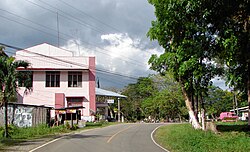Cortes, Bohol
| Cortes | |
|---|---|
| Municipality | |

Cortes, Bohol
|
|
 Map of Bohol with Cortes highlighted |
|
| Location within the Philippines | |
| Coordinates: 9°43′N 123°53′E / 9.72°N 123.88°ECoordinates: 9°43′N 123°53′E / 9.72°N 123.88°E | |
| Country | Philippines |
| Region | Central Visayas (Region VII) |
| Province | Bohol |
| District | 1st district of Bohol |
| Barangay |
14 (see § Barangays)
|
| Government | |
| • Type | Sangguniang Bayan |
| • Mayor | Lynn Lim (LP) |
| • Vice mayor | Leo Pabutoy |
| • Town Council |
Members
|
| • Representative | Rene Relampagos |
| Area | |
| • Total | 27.32 km2 (10.55 sq mi) |
| Population (2015 census) | |
| • Total | 16,954 |
| • Density | 620/km2 (1,600/sq mi) |
| • Voter (2016) | 10,566 |
| Time zone | PST (UTC+8) |
| ZIP code | 6341 |
| IDD : area code | +63 (0)38 |
| Income class | 5th class |
| PSGC | 071216000 |
Cortes is a 5th municipal income class municipality in the province of Bohol, Philippines. According to the 2015 census, it has a population of 16,954. In the 2016 electoral roll, it had 10,566 registered voters. It is about 10 kilometres (6.2 mi) northeast of Tagbilaran. Its nearest neighbor along the national highway to the north is the town of Maribojoc. Located high up on a plateau, the town occupies a total land area of 27.32 square kilometres (10.5 sq mi).
The history of Cortes dates back to pre-Hispanic times – there already was a form of government way before the coming of the Spaniards. The town was known as "Malabago" after its chief, who was a contemporary of King Lomod, otherwise known as Tamblot – the first Boholano to raise arms against the Spanish conquistadors.
The Malabago settlement was situated in the upland territory of the present day Cortes near the Abatan River while that of Tamblot was at barangay Viga in the lowlands of Antequera which stretches to the riverside valleys opposite that of Malabago beyond the present day Abatan Bridge. The people of Malabago have a culture of their own and recorded their day-to-day activities in their own writing using unique characters which they carved out on a piece of bamboo using a knife called panggi or supok. Malabago then was a farming community that cultivated the land and made rice paddies in the north and east lowlands.
Tamblot's reign started in early 1600 AD and the uprising in 1621 was triggered when a Spanish priest want to take back a silver church bell (Lingganayng Ugis) which he gave to Tamblot in order to put it up in a church he built at Malabago. Tamblot resented such a move; refused to give the bell back and so started the feud between him and the Spaniards. Supporting Tamblot during the uprising, the Malabago settlement was destroyed by the Spaniards in 1621.
The settlement was transferred to Bahian which was also destroyed by the Spaniards. Again the people settled at Ylaya at the upper part of the river. Not accessible by boats, the people had to berth near the mouth of the river which they eventually called as "Dayhangan", meaning "berthing place".
The people chose to live near the mouth of the river and along the swamps. Their main livelihood was to catch fish, so the new settlement was called "Pamingwitan" ('a place where one can catch fish using a fishing rod'). In 1793 or 94, an independent parish was established.
...
Wikipedia

